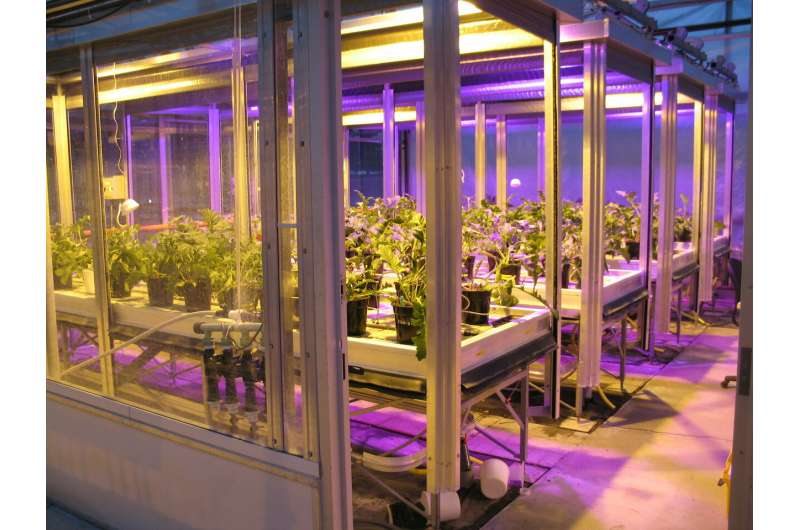Benches alternatingly lit with HPS or LED supplemental lights. Credit: David Llewellyn
In Canada, as in other higher latitudes, there is not enough natural light for production of many greenhouse commodities during the darker months of the year. In these regions, it is necessary for growers of year-round commodities to augment their naturally occurring lighting deficit with artificial lighting to meet their crops' economic minimum lighting requirements.
Until recently, the most economically viable supplemental lighting solution available to greenhouse growers has been high-pressure sodium (HPS) lamps. However, light-emitting diode (LED) technology has improved significantly in recent years and now offers the promise of providing greater energy efficiency and targeted wavelength light in long-lasting fixtures.
Some horticultural LED technologies can dramatically modify intensity and spectral output in real time, increasing their potential to be used for photosynthetic, photomorphogenic, and photoperiodic applications.
Dave Llewellyn, Katherine Schiestel, and Youbin Zheng conducted a study at the University of Guelph to determine the degree to which these LED advancements could benefit greenhouses in the care and proliferation of plants during longer-term exposure to supplemental lighting and to investigate the potential for LED lighting technologies to replace conventional HPS lighting systems. The researchers investigated the production of here varieties of cut gerbera under either HPS or LED supplemental lighting at the same canopy-level intensities.
Their conclusions are detailed in the article "Light-emitting Diodes Can Replace High-pressure Sodium Lighting for Cut Gerbera Production", found in HortScience.
Most of the treatment effects on harvest and postharvest quality metrics of marketable flowers indicated that the LED treatment usually produced higher-quality flowers than the HPS treatment. However, it is unclear whether the magnitude of any of the observed treatment differences would result in economically significant increases in crop productivity or profit.
The authors concluded that LEDs were capable of replacing HPS for supplemental lighting for cut gerbera production during darker periods. Economic factors related to initial cost and potential electricity costs would need to be evaluated on a case-by-case basis to determine which supplemental lighting solution is most appropriate for every grower and production scenario.
It is a commonly held belief that supplemental HPS lighting increases the canopy temperature relative to LED lighting due to inherently higher levels of radiant heat directed from HPS fixtures toward the canopy. Whether added heat is a benefit or a liability depends on the production scenario and environmental control strategy, although foliar heating is often touted as a benefit of HPS lighting.
The researchers discovered that LED lighting is generally more beneficial to greenhouse production than is HPS lighting.
More information: Dave Llewellyn et al, Light-emitting Diodes Can Replace High-pressure Sodium Lighting for Cut Gerbera Production, HortScience (2019). DOI: 10.21273/HORTSCI13270-18
Journal information: HortScience
Provided by American Society for Horticultural Science





















